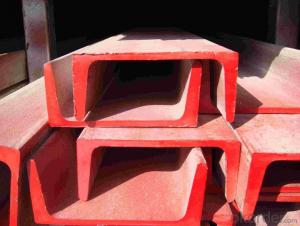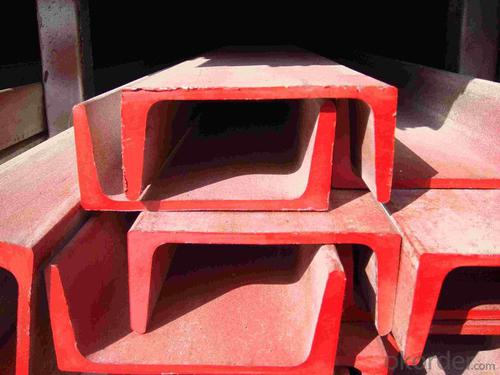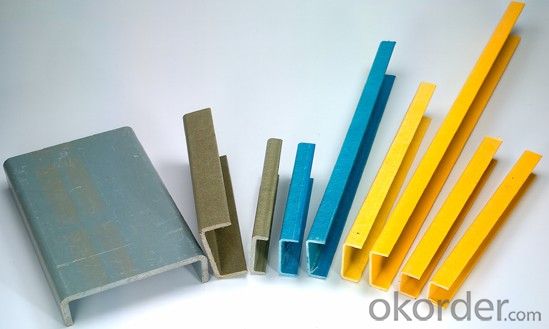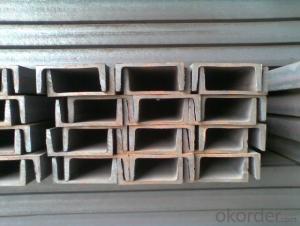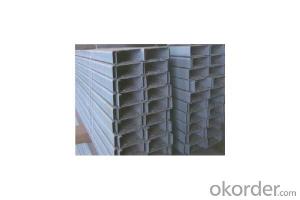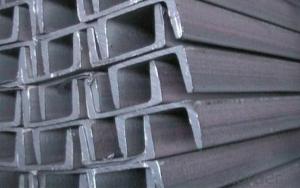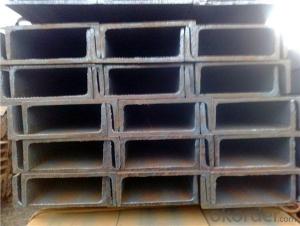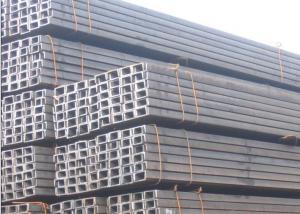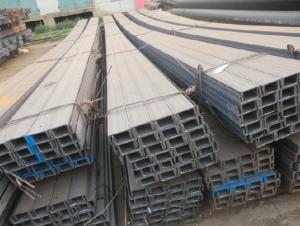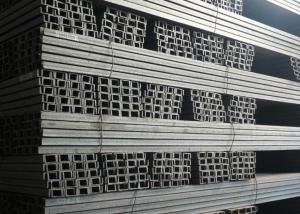Hot Rolled Galvanized Lip C Channel Steel Q195-Q235
- Loading Port:
- Tianjin
- Payment Terms:
- TT OR LC
- Min Order Qty:
- 4000 PCS
- Supply Capability:
- 38000 PCS/month
OKorder Service Pledge
Quality Product, Order Online Tracking, Timely Delivery
OKorder Financial Service
Credit Rating, Credit Services, Credit Purchasing
You Might Also Like
Hot Rolled Galvanized Lip C Channel Steel Q195-Q235 Details
| Standard: | AISI,ASTM,BS,DIN,GB,JIS | Dimensions: | 150*75*25*3.0mm | Grade: | carbon steel |
| Place of Origin: | China (Mainland) | Brand Name: | CNBM | Model Number: | 150mm*75mm*25mm*3.0mm |
| Shape: | C Channel | Application: | construction structure | Perforated Or Not: | Not Perforated |
| Grade:: | Q235,Q195,Q345,SS400,A36 | Length: | 3m, 6m, 9m, 12m, or as your request | Standard: | GB/ JIS |
| Size:: | 80*50mm--240*80mm | Surface:: | Perfect/ Galvanized/ oiled/ painted/ make holes | Technique: | Hot rolled/ cold rolled |
Packaging & Delivery
| Packaging Detail: | standard seaworthy packing or as your requirements. |
| Delivery Detail: | within 25- 35 days after signing the contract |
Hot Rolled Galvanized Lip C Channel Steel Q195-Q235 Specification
| Standard | AISI,ASTM,GB,JIS,DIN |
| Grade | Q195, Q215, Q235, ETC |
| Thickness | 1.0-4.0mm |
| Width | 30-350mm |
| Depth | 15-110mm |
| Lip Width | 10-30mm |
| Surface | Balce or Galvanized |
| usage | widely used in the purlin and wall beam of steel structure building, can be combined to make light weight roof truss, brecket, construction component, can be used in the production of beams and column, arm, in light industry machinery, etc. |
Hot Rolled Galvanized Lip C Channel Steel Q195-Q235 Pictures
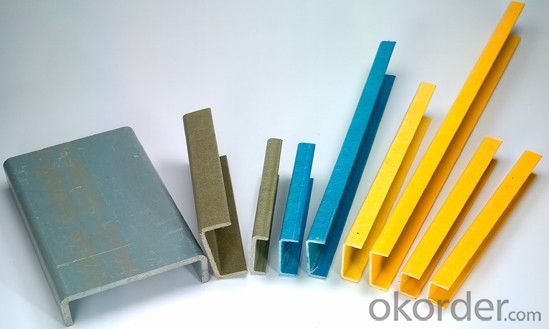
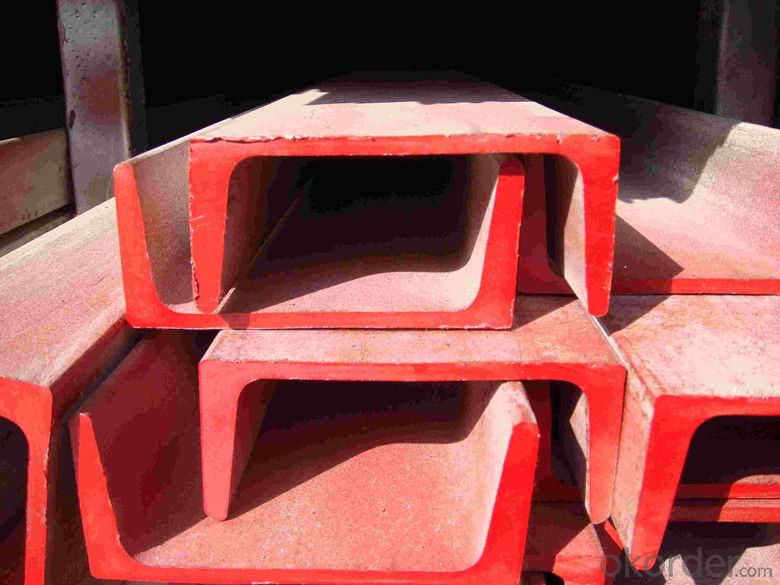

- Q: What are the safety considerations for working with steel channels?
- To ensure the well-being of individuals involved in the process of working with steel channels, it is important to take several safety considerations into account. 1. Personal Protective Equipment (PPE): It is crucial to wear the necessary PPE, which includes safety glasses, steel-toed boots, gloves, and a hard hat. This equipment provides protection against potential hazards such as falling objects, sharp edges, and sparks. 2. Lifting and handling: Steel channels can be heavy and unwieldy. Therefore, it is essential to use proper lifting techniques. This involves bending the knees and using the legs to lift instead of the back. For heavier channels, mechanical lifting devices like cranes or forklifts should be used. 3. Secure storage and stacking: When not in use, steel channels should be stored in a dedicated and stable area. Stacking should be done with care, ensuring that the channels are properly supported and won't topple over. 4. Precautions for cutting and welding: Proper ventilation is crucial while cutting or welding steel channels to prevent inhaling fumes and gases. Adequate ventilation systems should be in place, and workers should wear the appropriate respiratory protection when necessary. To prevent sparks from igniting nearby flammable materials, fire-resistant curtains or shields should be used. 5. Sharp edges and burrs: Steel channels can have sharp edges or burrs that may cause cuts or injuries. Before working with the channels, it is important to inspect and remove any sharp edges or burrs. Wearing cut-resistant gloves can provide an additional layer of protection. 6. Tripping and slipping hazards: Steel channels left unsecured on the ground can create tripping hazards. Workers need to ensure that the work area is free of obstructions or debris that could cause slips or falls. 7. Training and supervision: All individuals involved in working with steel channels should receive proper training and supervision. This includes understanding correct handling techniques, safety protocols, and emergency procedures. Regular safety meetings and inspections should also be conducted to maintain a safe working environment. By considering these safety measures when working with steel channels, the risk of accidents, injuries, and material damage can be significantly reduced, creating a safer and more productive working environment.
- Q: What are the different types of steel channel connections?
- There are several different types of steel channel connections that are commonly used in construction and structural engineering. Some of the most common types include: 1. Welded connections: This is the most common type of steel channel connection. It involves welding the ends of two or more channels together to create a strong and durable connection. Welded connections are typically used when the load on the channel is relatively low and the connection does not need to be adjustable. 2. Bolted connections: Bolted connections involve using bolts and nuts to connect two or more channels together. This type of connection is commonly used when the load on the channel is higher and the connection needs to be adjustable or removable. Bolted connections are also easier to install and modify compared to welded connections. 3. Riveted connections: Riveted connections were commonly used in the past but are now less common due to the labor-intensive nature of the process. Riveted connections involve using rivets to connect two or more channels together. This type of connection provides good strength and durability but requires specialized tools and skills for installation. 4. Gusset plate connections: Gusset plate connections involve using a steel plate, known as a gusset plate, to connect two or more channels together. The gusset plate is typically welded or bolted to the channels, providing additional strength and stability to the connection. This type of connection is commonly used in truss structures and other applications where the load on the channel is significant. 5. Cleat connections: Cleat connections involve using a steel plate, known as a cleat, to connect a channel to another structural member, such as a beam or column. The cleat is typically bolted or welded to the channel and the other member, providing a strong and stable connection. Cleat connections are commonly used in steel frame construction. These are just a few examples of the different types of steel channel connections that are commonly used in construction and structural engineering. The choice of connection type depends on various factors such as load capacity, adjustability, installation requirements, and design considerations.
- Q: How are steel channels used in the construction of warehouses?
- Due to their strength and versatility, steel channels find common usage in warehouse construction. Their primary function is to provide support and structural stability to the building. This is achieved by using them as beams or columns to evenly distribute heavy loads throughout the warehouse. Steel channels can withstand the weight of storage racks, equipment, and inventory, making them an indispensable component in warehouse construction. Aside from their role in structural support, steel channels also serve framing and bracing purposes. They help establish a framework for the building, allowing for the installation of walls, roofs, and other components. By doing so, steel channels ensure that the warehouse is capable of withstanding external forces such as wind and seismic loads. In addition, steel channels find application in constructing mezzanine floors within warehouses. These intermediate levels are commonly used for storage or office space and require sturdy and durable support. Steel channels provide the necessary strength and stability to ensure the safety and functionality of these additional levels. Furthermore, steel channels are frequently utilized in the construction of conveyor systems in warehouses. These systems facilitate the transportation of goods and materials throughout the facility. Steel channels provide a robust base for the conveyor belts, ensuring smooth and efficient movement of items. In summary, steel channels have a crucial role in warehouse construction, fulfilling functions such as providing structural support, framing, bracing, and support for mezzanine floors and conveyor systems. Their durability, strength, and versatility make them an ideal choice for warehouse construction, guaranteeing the safety, efficiency, and longevity of these structures.
- Q: Are steel channels available in pre-galvanized finishes?
- Yes, steel channels are available in pre-galvanized finishes. Pre-galvanization is a process where the steel is coated with a layer of zinc before it is formed into the desired shape, such as a channel. This protective zinc coating helps to prevent corrosion and provides added durability to the steel channel. Pre-galvanized steel channels are commonly used in various applications, including construction, manufacturing, and infrastructure projects. The pre-galvanized finish ensures that the steel channel is protected from rust and other forms of degradation, making it suitable for both indoor and outdoor use.
- Q: Are steel channels suitable for structural applications?
- Yes, steel channels are suitable for structural applications. Steel channels are commonly used in the construction industry for structural purposes due to their strength and durability. They provide excellent load-bearing capabilities, making them ideal for supporting heavy loads and spanning long distances. Steel channels also have good resistance to bending and twisting forces, which enhances their structural integrity. Additionally, steel channels can be easily fabricated and welded, allowing for a wide range of design possibilities. Overall, steel channels offer a reliable and cost-effective solution for various structural applications, including building frames, bridges, and industrial structures.
- Q: What are the different methods of reinforcing steel channels?
- There exist several techniques employed in enhancing the strength of steel channels, contingent upon the particular requirements and design factors involved. Some of the prevalent techniques encompass: 1. Welding: The most conventional and widely utilized method for reinforcing steel channels is welding. This process entails the fusion of supplementary steel plates or angles to the channel using heat and pressure. This technique ensures exceptional robustness and durability, enabling the reinforced channel to withstand substantial loads and stresses. 2. Bolting: Bolting is yet another frequently employed technique in reinforcing steel channels. It involves fastening additional steel plates or angles to the channel using bolts and nuts. This method is relatively swift and straightforward, permitting flexibility in making adjustments or modifications if necessary. 3. Riveting: Riveting is a method akin to bolting, except it employs rivets to secure the supplementary steel plates or angles to the channel. Riveting guarantees a firm and enduring connection, ensuring the reinforcement remains intact under diverse loading conditions. 4. Adhesive bonding: Adhesive bonding represents a contemporary approach that employs high-strength adhesives to affix additional steel plates or angles to the channel. This technique offers several advantages, including uniform distribution of loads, minimized stress concentrations, and improved aesthetics by eliminating the need for visible fasteners. 5. Fiber-reinforced polymers (FRP): FRP materials, such as carbon fiber or fiberglass, can be utilized to fortify steel channels. These materials possess lightweight properties, corrosion resistance, and high tensile strength. FRP can either be bonded or wrapped around the channel, providing supplementary reinforcement and enhancing its load-carrying capacity. 6. Composite construction: Composite construction involves the amalgamation of diverse materials, like concrete and steel, to reinforce steel channels. This technique is frequently employed in construction projects necessitating channel support for heavy loads or resistance against external forces, such as earthquakes or wind. It is imperative to note that the selection of a reinforcement method depends on various factors, including structural requirements, budgetary limitations, and environmental considerations. Consulting a structural engineer or construction professional is vital in determining the most suitable technique for reinforcing steel channels in a specific application.
- Q: What are the limitations of using steel channels?
- There are several limitations associated with using steel channels in various applications. Firstly, one of the main limitations is cost. Steel channels can be relatively expensive compared to other materials such as wood or certain types of plastics. This higher cost can make it less feasible for certain projects or industries with strict budget constraints. Secondly, steel channels are generally quite heavy and bulky, which can make transportation and installation more challenging. The weight of steel can require additional labor and equipment, increasing overall project costs and potentially limiting its use in certain applications where weight is a critical factor. Another limitation is corrosion. Steel is prone to rusting and corrosion over time, especially in environments with high moisture or exposure to certain chemicals. This corrosion can weaken the structural integrity of the steel channel and may require regular maintenance or protective coatings to prevent or slow down the corrosion process. Additionally, steel channels have limitations in terms of design flexibility. Unlike other materials such as wood or plastic, steel channels are not easily shaped or molded into complex or intricate designs. This lack of design flexibility can limit their use in certain architectural or decorative applications where aesthetic considerations are important. Lastly, steel channels can conduct heat and electricity, which may not be desirable in certain applications. For example, in electrical systems or sensitive electronic equipment, steel channels may need to be insulated or replaced with non-conductive materials to prevent electrical hazards or interference. Overall, while steel channels are strong and durable, they do come with limitations in terms of cost, weight, corrosion, design flexibility, and electrical conductivity. These limitations need to be carefully considered when deciding on the suitability of steel channels for a particular project or application.
- Q: Are steel channels resistant to corrosion?
- Yes, steel channels are generally resistant to corrosion. They are commonly made from stainless steel or galvanized steel, both of which have protective coatings that provide excellent resistance against rust and corrosion.
- Q: How do steel channels contribute to the stability of a structure during high winds?
- There are several ways in which steel channels contribute to the stability of a structure during high winds. To begin with, they provide support and reinforcement to the overall framework of a building. Typically used as beams or columns, steel channels are strong and rigid, effectively distributing the forces exerted by high winds throughout the structure. This prevents the building from swaying or collapsing under the intense wind pressure. Moreover, steel channels have excellent resistance to bending and torsion, enabling them to withstand the dynamic loads associated with high winds. Their robustness ensures that the structure remains intact and maintains its shape even when faced with strong gusts. Strategically positioning steel channels in critical areas of a building, such as corners or near openings, further enhances its stability during high winds. By reinforcing these vulnerable points, the channels minimize the risk of structural failure or damage. Furthermore, steel channels are often combined with other structural elements, such as braces or cross beams, to create a more rigid and stable framework. This combination of different structural components effectively increases the overall strength and resilience of the building, providing further protection against the impact of high winds. In summary, the role of steel channels in ensuring the stability of a structure during high winds is crucial. Their strength, rigidity, and ability to distribute and withstand forces contribute to the overall structural integrity, preventing the building from being compromised by strong winds and ensuring the safety of its occupants.
- Q: How do steel channels perform under cyclic loading?
- Steel channels have a tendency to perform well when subjected to cyclic loading due to their inherent strength and durability. The unique shape of steel channels, which includes flanges and a web, offers structural stability and resistance against bending, shearing, and torsion forces. This makes them particularly suitable for applications where cyclic loading is present, such as bridges, industrial buildings, and machinery. When subjected to cyclic loading, steel channels demonstrate a high fatigue strength, meaning they can endure repeated loading and unloading cycles without significant deformation or failure. This is primarily due to the material properties of steel, which possess high elasticity and toughness. Additionally, steel channels possess a strong resistance to corrosion, which further enhances their performance under cyclic loading conditions. Furthermore, engineers have the ability to design steel channels with specific dimensions and cross-sections in order to optimize their performance under cyclic loading. By considering factors such as the expected magnitude and frequency of cyclic loading, as well as the material properties of the steel being used, engineers can calculate the necessary size and shape of the channel. This ensures that the steel channel can effectively distribute and withstand the cyclic loads, minimizing the risk of fatigue failure. However, it is important to acknowledge that the performance of steel channels under cyclic loading can be influenced by various factors, including the quality of the steel, the design and manufacturing process, and the installation and maintenance practices. Therefore, proper material selection, design considerations, and regular inspections are necessary to ensure the long-term performance and safety of steel channels under cyclic loading.
Send your message to us
Hot Rolled Galvanized Lip C Channel Steel Q195-Q235
- Loading Port:
- Tianjin
- Payment Terms:
- TT OR LC
- Min Order Qty:
- 4000 PCS
- Supply Capability:
- 38000 PCS/month
OKorder Service Pledge
Quality Product, Order Online Tracking, Timely Delivery
OKorder Financial Service
Credit Rating, Credit Services, Credit Purchasing
Similar products
Hot products
Hot Searches
Related keywords
